For those with the job of preserving the nation’s nuclear deterrent, the key requirement is a new-design weapon. “We need a modernized nuclear warhead that has high reliability, safety, and security features that are improved over what we currently have, and maintainability of design—which we absolutely do not have … today,” says Gen. Kevin P. Chilton, commander of US Strategic Command.
Yet when Sen. Byron L. Dorgan (D-N.D.) threatened the Bush Administration’s modest $10 million request to start planning for such a Reliable Replacement Warhead, almost nobody complained. The same was true last year when Congress excised an $88 million proposal. In both cases, the money was for studies only, yet even that innocuous step was too extravagant for lawmakers.
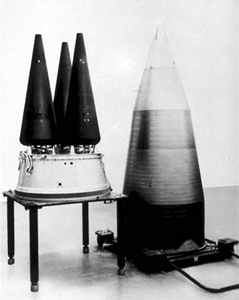 |
W78 warheads inside Mk12 re-entry vehicles, and shroud. |
The tug-of-war over the RRW is shaping up as a pivotal battle between two rival political camps espousing very different views about the future of the nuclear arsenal. Because the sums in question are so small, the RRW may seem an afterthought, but, to the interested parties, it is anything but.
On one side are the Bush Administration and the US armed forces, which believe a nuclear deterrent will be needed far into the future. They see problems sticking with the aged arsenal. All of the nuclear warheads in the current stockpile were designed and built during the Cold War. They are not as rugged, safe, and reliable as military planners would like them to be. Of course, the age of the weapons causes concern; small but untested changes are piling up, adding to operational uncertainty.
Nuclear Opposition
On the other side of the RRW debate are arms control and nonproliferation advocates, religious groups, and assorted national security luminaries—namely, former Senate Armed Services Committee Chairman Sam Nunn, Former Secretaries of State Henry A. Kissinger and George P. Shultz, and former Secretary of Defense William J. Perry. These critics say that international disarmament can help rein in the spread of nuclear weapons. In their view, the US should move faster toward the goal of nuclear abolition and stop modernizing the arsenal altogether.
In short, this tiny budget item serves as a proxy for large and explosive strategic disputes about the proper role of nuclear weapons in today’s defense equation.
That a mere study of a new warhead can excite such passions speaks volumes about the charged political atmosphere surrounding nuclear weapons. Congress has created a strategic arms review commission, and Democrats vow to block RRW moves until the commission reports at the end of this year. Congress also has tasked DOD to submit next year the results of a comprehensive nuclear weapons review.
As both studies will no doubt make clear, the RRW program is intimately related to sensitive US nuclear problems. Among them:
-
An aged arsenal, byproduct of Washington’s controversial 1992 decision to end all production of new weapons.
Complicating the situation is the collapse of a bipartisan political consensus on nuclear weapons that held throughout much of the Cold War. That consensus fractured in the 1980s, probably forever. Today, the split up is manifest in Democrat opposition to Bush Administration proposals to study a new bunker-busting nuclear weapon and similar efforts.
The arguments are complex, the stakes high. However, the true starting point for today’s clash of nuclear visions is clear enough. You can locate it in a dusty moonscape on the edge of the Great Basin out west, in a place that, for years, served as America’s ground zero in the nuclear arms race.
A prominent waypoint is a dry Nevada lake bed called Frenchman Flat, site of early nuclear blasts at the Nevada Test Site. Skeletons of cement-block buildings lie in twisted ruin, their walls long ago stripped bare by nuclear winds. The so-called “survivor village” was where scientists once measured the effect of nuclear blasts on habitats in the above-ground tests of the early 1960s. Nearby, just across a ridge, lies Yucca Flat, where the Atomic Age left its footprints in the form of hundreds of giant craters, testament to 30 years of underground nuclear tests. This area was once the nexus of the Cold War arms effort. More than 8,000 federal scientists, engineers, and contractors worked in the nearby base camp Mercury, a boomtown that boasted its own bowling alley and where people not only “thought the unthinkable,” they prepared for it.
Today, the entire area has the look and feel of a long-bygone era. America has not tested a nuclear weapon in more than 15 years—not since President George H. W. Bush in 1992 signed off on a moratorium halting new underground explosions. Related to that fact is another one: The nation has not designed or manufactured a new nuclear warhead in nearly 20 years.
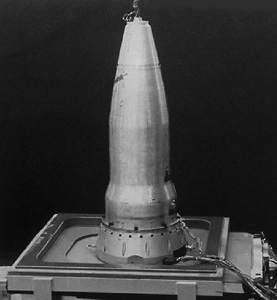 |
A W89 warhead. |
America’s once vast nuclear production complex—which included no fewer than seven major production facilities—now is roughly a fifth its former size. Under a “complex transformation” initiative, the National Nuclear Security Administration—overseer of the weapons efforts—plans to shrink the footprint of the nuclear complex by another third, and cut the number of workers directly supporting nuclear weapons activities by an additional 20 to 30 percent.
Vanishing Breed
Fast disappearing is the small corps of experienced nuclear scientists and engineers still working at the Los Alamos, Sandia, and Lawrence Livermore National Laboratories (the first two in New Mexico, the third in California). NNSA estimates that, in under five years, the last of the nuclear designers who have actually tested weapons will either have retired or otherwise departed the scene.
Thus, the keys to the American nuclear deterrent force are passing into the hands of a new generation of scientists who have never designed or tested an actual weapon. Their experience of the past 15 years has been rather different; they have monitored the effect of time on an aging stockpile. To do this, they have used a series of high-tech laboratory and computer experiments cumulatively dubbed “Science-based Stockpile Stewardship.”
Though many failed to grasp it at the time, Washington’s decision to forgo nuclear testing and production marked a radical departure from the norm. The four other major declared nuclear powers—Russia, China, Britain, and France—also embraced the test moratorium. Unlike the US, however, they all have continued to produce new weapons based on old designs validated by historical nuclear tests. In this way, these nations kept intact their nuclear production bases and thus eliminated concerns about the effect of aging on their stockpiles.
Today, US officials concede certain uncomfortable truths about the decision to indefinitely rely on legacy nuclear weapons maintained under a scientific monitoring regime.
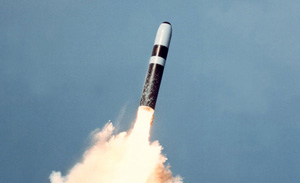 |
Trident II missiles such as this one carry the W76 weapon. |
They note that this momentous decision was as much about budgets and politics as it was about actual strategic necessity and scientific capability. At the end of the Cold War, defense budgets were in sharp decline, and defense officials were more or less forced into a trade-off. They could have a cutting-edge nuclear science and research base, or they could have a strong nuclear weapons manufacturing base, but not both. They chose the science and research base.
Said NNSA head Thomas P. D’Agostino, “The end of the Cold War was a welcome event, but it has had enormous implications for our nuclear weapons programs and the infrastructure of the nuclear weapons complex.”
In signing on to Stockpile Stewardship, Congress committed itself to one of the largest science programs since the original Manhattan Project that produced the World War II atomic weapon. The more than $50 billion expended thus far has led to creation of highly advanced scientific tools such as the world’s most advanced particle accelerator, lasers, and supercomputers.
Energy Department officials hoped that the opportunity to work with such state-of-the-art scientific tools would attract a new, post-Cold War generation of nuclear scientists, even though the Soviet threat had disappeared and work on “weapons of mass destruction” had largely lost its allure on college campuses.
“A strategic decision was made at the time to sustain and strengthen scientific and technical activities in order to ensure a future capability to certify the [existing] stockpile,” D’Agostino said. “While this was a reasonable decision given the limited resources, in effect we mortgaged the present to ensure the future.”
The downside came into clear view in 2003, when officials from NNSA and the national laboratories gathered to take stock of things after a decade of Stockpile Stewardship.
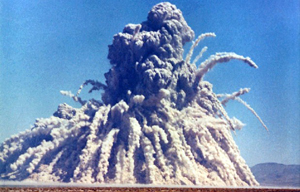 |
A shallow underground nuclear explosion in Nevada in 1962. |
They realized that the United States was now in possession of a small and still shrinking warhead inventory, the smallest since the Eisenhower Administration. Nuclear experts worry that a small arsenal of few warhead types becomes progressively more vulnerable to problems that can crop up in any one warhead design.
They cite, as a cautionary example, the W76 warhead, which sits atop the Navy’s Trident D5 missile and comprises a sizeable percentage of the firepower resident in America’s sea-based nuclear force. The W76’s planned life extension program was delayed when NNSA ran into problems restarting a vendor base shut down many years before. If serious problems had been discovered, the nation would have lacked a manufacturing base to quickly replace the warhead. That would have undermined the credibility of one leg of the strategic nuclear triad.
The earliest design studies for a possible Reliable Replacement Warhead centered on replacing the W76, but with a new design that could also serve as a backup for ICBM-mounted weapons in the event they experienced problems. As Air Force officials note, current non-RRW plans call for the nation to deploy in the 2020s many of the same ICBM warheads that were first put into operation in the 1970s.
Though the Stockpile Stewardship program has not yet identified any anomalies associated with age that would prompt a crisis of confidence, experts emphasize that they have found problems sufficient to generate operational restrictions of some weapons.
“My … long-term concern is the continuing accumulation of change to the stockpile,” said Michael R. Anastasio, director of the Los Alamos National Laboratory, testifying recently before Congress. “These changes will increase performance uncertainties, and pose increasing risk in a low-margin, legacy Cold War weapons stockpile.”
Indeed, in taking stock in 2003, laboratory and NNSA officials thought long and hard about the uncertainties that would be added to an already complex nuclear equation by successive life extension programs.
As a result of their deliberations, NNSA officials and national laboratory directors all endorsed the RRW concept, which would bring about a resumption of nuclear weapons production. They included in the proposal the bluntest stockpile reliability warnings anyone had heard since the start of the moratorium. Said D’Agostino, “The main conclusion was that, as we continue to draw down the stockpile, we have become concerned that our current path may pose an unacceptable risk … over the long term.”
With every life extension program on a weapon, he noted, scientists move further away from the designs that were certified with underground nuclear tests.
Long-Term Confidence
“These inevitable accumulations of small changes over the extended lives of these highly optimized and complicated systems have given rise to concerns about the reliability of the weapons over time,” he said. “While we are confident that today’s stockpile is safe and reliable, it is only prudent to explore alternative means to ensure stockpile reliability over the long term. After all, we are dealing with nuclear weapons, and any error or slight uncertainty is an unacceptable risk.”
The Secretaries of Defense, Energy, and State last year declared to Congress that the RRW program is key to preservation of long-term confidence in the United States nuclear deterrent capability.
That, in a nutshell, was the impetus for the new warhead.
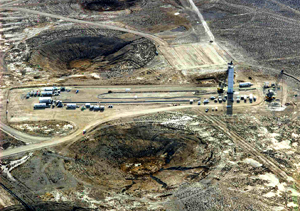 |
Craters from previous tests. (DOE photo) |
Fully aware of the inhospitable political climate they faced, NNSA and laboratory officials have been at pains to avoid characterizing the RRW as a “new” nuclear warhead, though there is no doubt it would be. Instead they have emphasized that RRW’s attributes are consistent with American environmental and nonproliferation goals, and would replicate—but not improve upon—the military capabilities of existing warheads. It would not, for instance, carry an increased nuclear “yield.” Put in automotive terms, the US would endeavor to build a safer, more reliable, but no more powerful, 1988 Chevy Caprice.
Proponents pointed out that a replacement warhead might actually allow for additional stockpile reductions, in that the nation would no longer need to keep large reserves of warheads in storage in case problems are discovered in deployed weapons systems. A modernized and much-consolidated nuclear production base would serve as insurance against unanticipated problems, and permit officials to phase out the use of beryllium oxide and other extremely toxic materials associated with the Cold War arsenal. Moreover, the RRW would incorporate state-of-the-art security technology that makes the warheads virtually impervious to detonation even if one were to fall into the wrong hands. Finally, NNSA officials insist that state-of-the-art Stockpile Stewardship tools will allow them to design, build, and deploy the RRW without the need for underground testing.
Even so, anti-nuclear political forces are skeptical.
“The interesting thing … is that we have a lot of nuclear weapons, we talk a lot about them, [yet] we can’t possibly use one ever, without catastrophic results for our planet,” said Dorgan, chairman of the Senate subcommittee with jurisdiction over DOE’s weapon complex. “We’ve signed up as a country to go to zero nuclear weapons at some point in the future. We will not do that, of course, until it is … determined to be safe and secure for our country, … [but] nuclear nonproliferation is very important.”
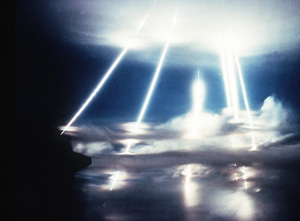 |
Re-entry vehicles strike Kwajalein Atoll in the Marshall Islands, after a 4,753-mile flight from Vandenberg AFB, Calif. |
As part of the Presidential directive establishing the Stockpile Stewardship program, an annual certification process is conducted by the keepers of the nuclear flame at the Departments of Energy and Defense—including the directors of the three weapons labs. In recent years, they have affirmed the safety and reliability of the stockpile, even while simultaneously voicing increasing concern about the long-term viability of an arsenal that is already decades old.
Those concerns could conceivably lead at some point to a decision against certification. At that point, the President, by law, would be required to invoke a “supreme national interest” claim and resume nuclear testing. Then, the contentious debate about the Reliable Replacement Warhead and the nuclear stockpile will shift back to the familiar ground where it all began, the cratered landscape of Nevada. That time might not be far off.
James Kitfield is the defense correspondent for National Journal in Washington, D.C. His most recent article for Air Force Magazine, “On African Ground,” appeared in the February issue.